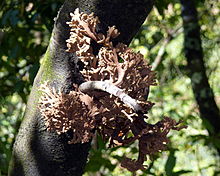Naked basidiae
| Naked basidiae | ||||||||||||
|---|---|---|---|---|---|---|---|---|---|---|---|---|

Effects of the plant parsite Exobasidium vaccinii |
||||||||||||
| Systematics | ||||||||||||
|
||||||||||||
| Scientific name | ||||||||||||
| Exobasidiales | ||||||||||||
| Henn. |
The naked basidia (Exobasidiales) are a group of smut fungi (Ustilaginomycotina) and, like all smut fungi, are plant parasites.
Features and way of life
The order is characterized by a complex interaction apparatus that establishes contact with the host cells via tubes. The representatives form Holobasidien and dimorphisch, so alternately form saprobiontisch living Hefestadien and parasitically living mycelia . They do not form teliospores or ballisto conidia .
The hosts are monocotyledons and dicotyledons , the European representatives mainly infect Ericaceae . They do not form real fruiting bodies , the spores arise mainly on the leaves of the host. They trigger the formation of gall-like growths of the mesophyll in the host . The mycelium grows inside and / or outside the host cells.
The fungal hyphae penetrate the host cells with haustoria . With Graphiola , the haustoria are constricted at the entry point, wear a buckle and branch out into several lobes. In most species the haustoria are buckleless and not constricted, in Exobasidium they barely reach into the host cell, while in the other genera they reach far.
The hyphae penetrate the stomata to the outside and form unseptated basidia (holobasidia) here. The sterigms are blunt and strongly spreading, the basidiospores are curved towards each other. The basidiospores passively fall off. Germination takes place with transverse septa through the formation of conidia . In culture, the spores form yeast-like clusters of cells as they germinate.
Interaction apparatus
The interaction apparatus is created by initially collecting small, primary vesicles on the contact surface with the host cell. They fuse to form larger secondary vesicles, which are eventually connected to one another by long tubes. The resulting, coherent network of cisterns is filled with electron-tight material. The network is highly branched and has a number of nodular thickenings.
The cell-cell interaction begins with a circular penetration of electron-dense material into the fungal cell wall in the direction of the host plasma lemma . An electron-dense ring called an interaction ring comes into contact with the host's plasmalemma. A second burst of electron dense material follows in the zone of the ring. The cistern network fuses with the plasmalemma of the fungus and at least partially empties its contents. The result is an approximately spherical accumulation of material on the host plasma lemma. This material is then enveloped by host material. In some species, a third transfer of fungal material to the host follows. The functional significance of these processes has not yet been clarified.
In the species with haustoria there are several interaction apparatuses on each haustorium, but probably only one of them is always active.
Systematics
The naked basidia belong to the Exobasidiomycetes . The closest relatives are the Doassansiales , with whom the naked basidians share the complex apparatus of interaction. The monophyly of the nudist basid has been proven in several studies. The order is from Begerow et al. (2006) subdivided as follows:
- Exobasidiaceae
- Cryptobasidiaceae
-
Brachybasidiaceae
- Brachybasidium
- Dicellomyces
- Exobasidiellum
- Kordyana
- Meira (anamorphic)
- Proliferobasidium
- Graphiolaceae
supporting documents
- Robert Bauer, Franz Oberwinkler, Kálmán Vánky: Ultrastructural markers and systematics in smut fungi and allied taxa . Canadian Journal of Botany, Vol. 75, 1997, pp. 1273-1314.
- Dominik Begerow, Matthias Stoll, Robert Bauer: A phylogenetic hypothesis of Ustilaginomycotina based on multiple gene analyzes and morphological data . Mycologia, Vol. 98, 2006, pp. 906-916. doi : 10.3852 / mycologia.98.6.906
- A. Bresinsky, Ch. Körner, JW Kadereit, G. Neuhaus, U. Sonnewald: Strasburger - textbook of botany . 36th edition, Spektrum Akademischer Verlag, Heidelberg 2008, p. 673. ISBN 978-3-8274-1455-7
Individual evidence
- ↑ DS Hibbett and 66 other authors: A higher-level phylogenetic classification of the Fungi . Mycological research, Vol. 111, 2007, pp. 509-547. PMID 17572334 (PDF; 1.3 MB)
